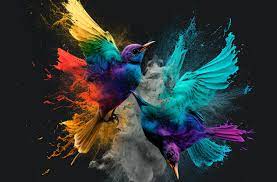The Art of Graphic Design
Graphic design is a creative and dynamic field that involves combining text, images, and other visual elements to convey messages effectively. It plays a crucial role in shaping how we perceive the world around us, from the logos on our favourite products to the layouts of magazines and websites.
At its core, graphic design is about communication. Designers use their skills to visually communicate ideas, emotions, and information in a way that is both aesthetically pleasing and easy to understand. Whether it’s creating a brand identity for a business or designing an eye-catching poster for an event, graphic design has the power to captivate audiences and leave a lasting impression.
One of the key principles of graphic design is balance. Designers carefully consider the placement of elements such as text, images, and whitespace to create harmonious compositions that draw the viewer’s eye. They also pay attention to colour theory, typography, and visual hierarchy to ensure that the message is conveyed clearly and effectively.
Technology has revolutionised the field of graphic design, giving designers access to a wide range of tools and software that enable them to bring their ideas to life. From Adobe Creative Suite to online platforms like Canva, designers have more resources than ever before to unleash their creativity and produce stunning visuals.
Graphic design is not just about making things look good; it’s about solving problems creatively. Whether it’s designing a user-friendly website or creating an engaging social media campaign, graphic designers use their skills to find innovative solutions that meet the needs of their clients and audiences.
In today’s digital age, where visual content dominates our screens and feeds, the demand for skilled graphic designers continues to grow. From branding agencies to marketing firms, businesses across industries are seeking talented designers who can help them stand out in a crowded marketplace.
Ultimately, graphic design is more than just a profession – it’s an art form that has the power to inspire, inform, and influence people in profound ways. So next time you see a beautifully designed logo or an eye-catching poster, take a moment to appreciate the artistry and creativity behind it.
5
- What is graphic design and what does a graphic designer do?
- What skills are needed to become a successful graphic designer?
- How important is typography in graphic design?
- What software do graphic designers use?
- How can graphic design benefit businesses and brands?
What is graphic design and what does a graphic designer do?
Graphic design is a multifaceted discipline that involves combining visual elements such as images, typography, and colours to communicate messages effectively. A graphic designer’s role is to create visually appealing designs that convey information, evoke emotions, and engage audiences across various mediums. They work on a wide range of projects, including branding, advertising, web design, print materials, and more. From designing logos and layouts to selecting fonts and colours, graphic designers use their creative skills and technical expertise to bring ideas to life in a visually compelling way. Their work not only enhances the aesthetics of a project but also plays a crucial role in shaping how we interact with the world around us.
What skills are needed to become a successful graphic designer?
To become a successful graphic designer, a combination of creativity, technical proficiency, and strong communication skills is essential. Creativity allows designers to think outside the box and come up with innovative solutions to visual problems. Technical skills, such as proficiency in design software like Adobe Creative Suite, are crucial for bringing ideas to life effectively. Additionally, strong communication skills help designers collaborate with clients and team members, understand project requirements, and convey their ideas clearly. Adaptability, attention to detail, and a passion for continuous learning are also key attributes that can set a graphic designer up for success in this dynamic and competitive field.
How important is typography in graphic design?
Typography plays a pivotal role in graphic design, serving as a cornerstone of visual communication. The choice of fonts, spacing, alignment, and overall typography design can significantly impact the readability, mood, and message of a design piece. Effective typography not only enhances the aesthetic appeal of a design but also helps convey information clearly and evokes specific emotions in the audience. It sets the tone for the overall design and plays a crucial role in creating a cohesive and harmonious visual experience. In essence, typography is an essential element that can make or break a graphic design project, highlighting its significance in the realm of visual communication.
What software do graphic designers use?
Graphic designers utilise a variety of software tools to bring their creative visions to life. Some of the most commonly used software in the industry includes Adobe Creative Suite, which encompasses popular applications like Photoshop for image editing, Illustrator for vector graphics, and InDesign for layout design. Other widely used tools include Sketch, CorelDRAW, and Canva, each offering unique features tailored to different aspects of graphic design. The choice of software often depends on the specific requirements of a project and the designer’s personal preferences, highlighting the diverse range of options available to professionals in the field of graphic design.
How can graphic design benefit businesses and brands?
Graphic design plays a pivotal role in enhancing the visual identity and communication of businesses and brands. By incorporating thoughtful design elements such as logos, colour schemes, typography, and imagery, companies can establish a strong brand presence that resonates with their target audience. Effective graphic design not only attracts attention but also conveys professionalism, credibility, and consistency across various marketing materials. It helps businesses differentiate themselves from competitors, build brand recognition, foster customer loyalty, and ultimately drive sales and growth. In today’s competitive market landscape, investing in strategic graphic design can be a powerful tool for businesses to make a lasting impact and connect with consumers on a deeper level.
